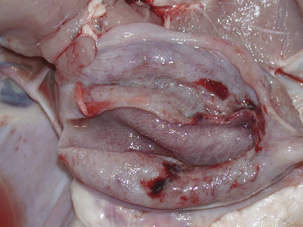Chapter 34 Other Gram-Positive Anaerobes
THE GENUS ACTINOBACULUM
The only clinical sign indicating initiation of cystitis is bacteriuria. In mild cases, lesions include epithelial cell hyperplasia, desquamation of superficial epithelial cells, and goblet cell metaplasia with intraepithelial cyst formation. Severe cases are characterized by necrotizing ureteritis and pyelitis (Figure 34-1), with accumulation of bacterial colonies, ascending renal infection, and uremia. Infection is frequently accompanied by hematuria and urinary pH greater than 8. The most severe infections are characterized by purulent ureteritis and pyelitis/pyelonephritis, and are likely to be caused by A. suis in concert with other bacteria, especially Escherichia coli. Recent studies suggest that a toxin produced by E. coli may damage the ureteric valve, allowing retrograde flow of urine into the kidneys, resulting in hydronephrosis.
< div class='tao-gold-member'>
Stay updated, free articles. Join our Telegram channel

Full access? Get Clinical Tree



